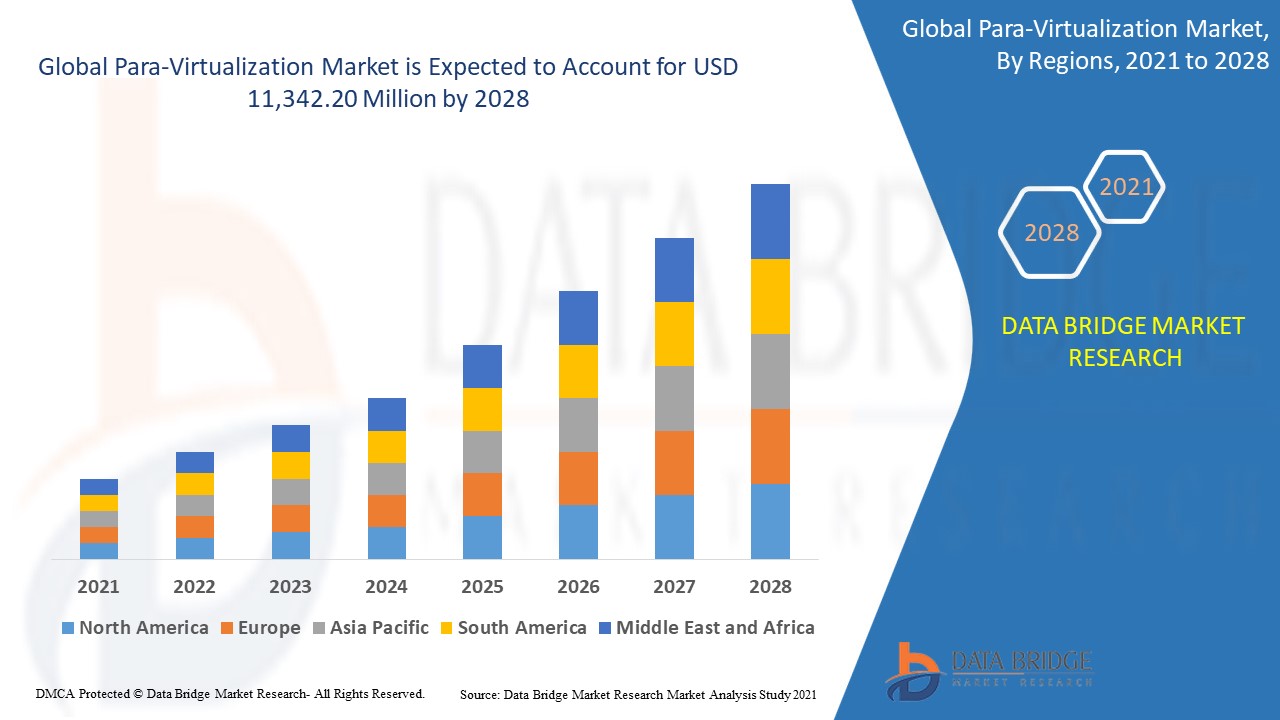Global Para-Virtualization Market, By Deployment (On-premises, Cloud), Organization Size (SMEs, Large Enterprises), Application (BFSI, Telecommunications and IT, Healthcare, Transportation and Logistics, BFSI, Others), Country (U.S., Canada, Mexico, Brazil, Argentina, Rest of South America, Germany, Italy, U.K., France, Spain, Netherlands, Belgium, Switzerland, Turkey, Russia, Rest of Europe, Japan, China, India, South Korea, Australia, Singapore, Malaysia, Thailand, Indonesia, Philippines, Rest of Asia-Pacific, Saudi Arabia, U.A.E, South Africa, Egypt, Israel, Rest of Middle East and Africa) Industry Trends and Forecast to 2028
Market Analysis and Insights: Global Para-Virtualization Market
The para-virtualization market is expected to witness market growth at a rate of 6.20% in the forecast period of 2021 to 2028 and is expected to reach USD 11,342.20 million by 2028. Data Bridge Market Research report on para-virtualization market provides analysis and insights regarding the various factors expected to be prevalent throughout the forecast period while providing their impacts on the market’s growth.
Virtualization Software, also known as hypervisor, accepts two or more OS to run on a single host machine or server. The software can operate on a machine without OS (Type 1) or on top of an OS (Type 2). It permits virtualization of components, like hardware, OS, network, or storage. Para virtualization (PV) is a development of the virtualization technology in which a guest operating system (guest OS) is altered earlier to system inside a virtual machine (VM) in order to permit all guest OS inside the system to share resources and positively collaborate, rather than make an attempt to outdo an entire hardware environment. With paravirtualization, virtual machines can be edited through interfaces that are related to the underlying hardware. This capacity minimizes overhead and improves system implementation by supporting the use of VMs that would otherwise be under usage in traditional or full hardware virtualization.
Factors such as direct communication between the guest kernel and the hypervisor that improvises the performance levels, the thin software layer formed in para virtualization controls virtual server traffic by permitting a single guest OS to gain contact to the physical hardware device while finishing admittance for all other guest OS, the para virtualization does not try to fully rebuild the hardware, there is lower virtualization overhead which in turn are expected to boost the growth of the para-virtualization market in the forecast period. Furthermore, para virtualization does not involve device drivers because it uses the drivers already present in the guest OS. Consequently, organizations are able to take full benefit of the hardware in the server as an alternative of being limited to hardware with accessible drivers, as is the case in full virtualization, the paravirtualization provides numerous performance benefits as well as effectiveness that provide improvised scaling. It is helpful in a range of technical fields are the factors that are anticipated to propel the growth of the para-virtualization market in the forecast period. However, the factors such as the guest OS must be customized exclusively to run on top of the virtual machine monitor (VMM), the host program that permits a single computer to support multiple, identical execution environments, restricting support to open source operating systems, since para virtualization cannot accomplish with unmodified guest OS, its compatibility and portability is minimal with systems like Microsoft Windows and the considerable support and maintenance concern may arise since the production environment needs complex guest kernel modifications are most likely expected to further hinder the growth of the para-virtualization market in the upcoming years.
This para-virtualization market report provides details of new recent developments, trade regulations, import export analysis, production analysis, value chain optimization, market share, impact of domestic and localised market players, analyses opportunities in terms of emerging revenue pockets, changes in market regulations, strategic market growth analysis, market size, category market growths, application niches and dominance, product approvals, product launches, geographic expansions, technological innovations in the market. To gain more info on para-virtualization market contact Data Bridge Market Research for an Analyst Brief, our team will help you take an informed market decision to achieve market growth.
Para-Virtualization Market Scope and Market Size
The para-virtualization market is segmented on the basis of deployment, organization size and application. The growth among segments helps you analyse niche pockets of growth and strategies to approach the market and determine your core application areas and the difference in your target markets.
- Based on the deployment, the para-virtualization market is segmented into on-premises, cloud.
- Based on the organization size, the para-virtualization market is segmented into small and medium-sized enterprise (SMEs), large enterprises.
- Based on the application, the para-virtualization market is segmented into BFSI, telecommunications and IT, healthcare, transportation and logistics, others.
Para-Virtualization Market Country Level Analysis
The para-virtualization market is analysed and market size, volume information is provided by country, deployment, organization size and application as referenced above.
The countries covered in the para-virtualization market report are the U.S., Canada and Mexico in North America, Brazil, Argentina and Rest of South America as part of South America, Germany, Italy, U.K., France, Spain, Netherlands, Belgium, Switzerland, Turkey, Russia, Rest of Europe in Europe, Japan, China, India, South Korea, Australia, Singapore, Malaysia, Thailand, Indonesia, Philippines, Rest of Asia-Pacific (APAC) in the Asia-Pacific (APAC), Saudi Arabia, U.A.E, South Africa, Egypt, Israel, Rest of Middle East and Africa (MEA) as a part of Middle East and Africa (MEA).
Asia-Pacific dominates the para-virtualization market because of the rising of the digitization projects and growing acceptance of virtualization technologies. Furthermore, the growing number of financial centers since financial data is crucial, therefore, it requires to be stored in a virtual server, for safety purpose. The escalating investments and advancements in the BFSI and IT and telecommunication industry is estimated to create advantageous opportunities for the market which in turn is expected to further boost the growth of the para-virtualization market in the region during the forecast period.
The country section of the report also provides individual market impacting factors and changes in regulation in the market domestically that impacts the current and future trends of the market. Data points like down-stream and upstream value chain analysis, technical trends and porter's five forces analysis, case studies are some of the pointers used to forecast the market scenario for individual countries. Also, the presence and availability of global brands and their challenges faced due to large or scarce competition from local and domestic brands, impact of domestic tariffs and trade routes are considered while providing forecast analysis of the country data.
Competitive Landscape and Para-Virtualization Market Share Analysis
The para-virtualization market competitive landscape provides details by competitor. Details included are company overview, company financials, revenue generated, market potential, investment in research and development, new market initiatives, regional presence, company strengths and weaknesses, product launch, product width and breadth, application dominance. The above data points provided are only related to the companies’ focus related to para-virtualization market.
The major players covered in the para-virtualization market report are VMware, Oracle, Red Hat, Citrix, Microsoft, Google LLC, I2K2 Networks, PCS, Huawei, and Proxmox Servers Solutions GmbH, Amazon.Com Inc. Odin Inc., Symantec Corporation, Google, Dell, Micro Focus, Parallels International, Systancia, Accops, NComputing, Sangfor Technologies, NextAxiom Technology, among other domestic and global players. Market share data is available for global, North America, Europe, Asia-Pacific (APAC), Middle East and Africa (MEA) and South America separately. DBMR analysts understand competitive strengths and provide competitive analysis for each competitor separately.
SKU-
Get online access to the report on the World's First Market Intelligence Cloud
- Interactive Data Analysis Dashboard
- Company Analysis Dashboard for high growth potential opportunities
- Research Analyst Access for customization & queries
- Competitor Analysis with Interactive dashboard
- Latest News, Updates & Trend analysis
- Harness the Power of Benchmark Analysis for Comprehensive Competitor Tracking
Research Methodology
Data collection and base year analysis are done using data collection modules with large sample sizes. The stage includes obtaining market information or related data through various sources and strategies. It includes examining and planning all the data acquired from the past in advance. It likewise envelops the examination of information inconsistencies seen across different information sources. The market data is analysed and estimated using market statistical and coherent models. Also, market share analysis and key trend analysis are the major success factors in the market report. To know more, please request an analyst call or drop down your inquiry.
The key research methodology used by DBMR research team is data triangulation which involves data mining, analysis of the impact of data variables on the market and primary (industry expert) validation. Data models include Vendor Positioning Grid, Market Time Line Analysis, Market Overview and Guide, Company Positioning Grid, Patent Analysis, Pricing Analysis, Company Market Share Analysis, Standards of Measurement, Global versus Regional and Vendor Share Analysis. To know more about the research methodology, drop in an inquiry to speak to our industry experts.
Customization Available
Data Bridge Market Research is a leader in advanced formative research. We take pride in servicing our existing and new customers with data and analysis that match and suits their goal. The report can be customized to include price trend analysis of target brands understanding the market for additional countries (ask for the list of countries), clinical trial results data, literature review, refurbished market and product base analysis. Market analysis of target competitors can be analyzed from technology-based analysis to market portfolio strategies. We can add as many competitors that you require data about in the format and data style you are looking for. Our team of analysts can also provide you data in crude raw excel files pivot tables (Fact book) or can assist you in creating presentations from the data sets available in the report.














